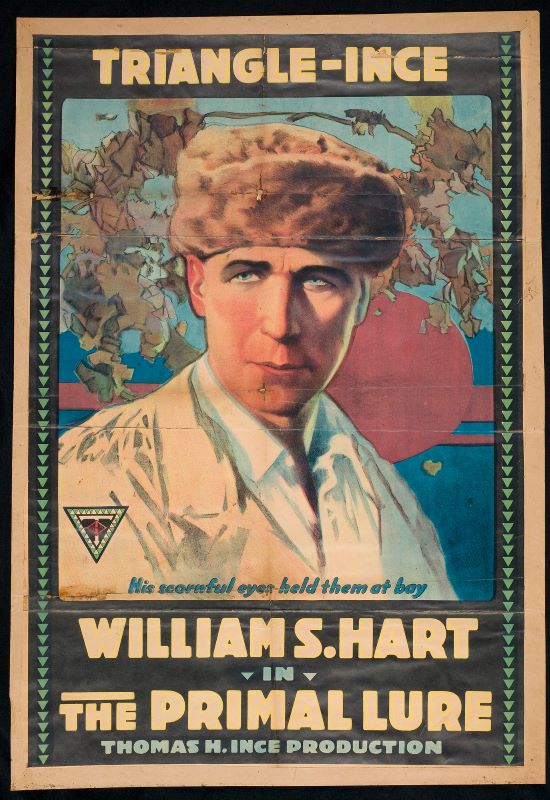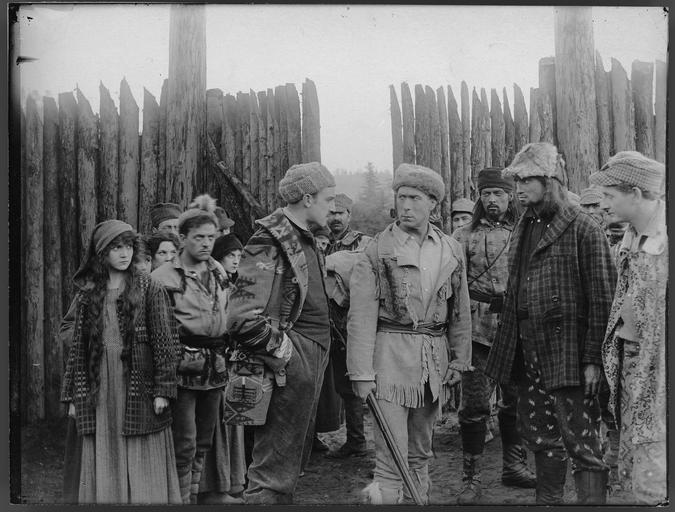The Movies Come to Felton | Local History
Plenty of Real Scenery for “The Primal Lure”
By Randall Brown
December 1915. The movie scouts needed to find a location for a Canadian Northwest story. The scenario called for forests, mountain trails, open clearings, and a river. Their instructions were clear: “No phony scenery.” They chose Felton.
Carpenters quickly set to work recreating “Fort Lu Cerne,” a frontier trading post—log cabins surrounded by an imposing redwood stockade. The site, “a level clearing at the foot of a wooded hill” is now part of the SLV High School athletic field.
The players arrived a few days later. William S. Hart, the star of the picture, liked Felton immediately. It looked like the Dodge City he had known as a child, dirt streets and all. He checked into the Featherston’s hotel in the old Cremer building, where his “at home” feeling was reinforced by Florence’s famous cooking and, undoubtedly, George’s ample supply of mountain wine and fine liquors.

Promotional poster for The Primal Lure movie filmed in Felton, California
The cast included 20 Sioux actors, hired to portray a Native American tribe. They were friends of Hart, who had learned their language at an early age. The first shots were filmed along the river. “The San Lorenzo is a raging torrent at this season of the year,” noted the Mountain Echo, “and the water is ice cold, still the Indians with the motion picture company are taking daily trips in frail canoes. Some of the spills and rescues are almost too realistic.” Not to be outdone, Hart and the villain staged a “thrilling” knockdown fight that culminated in a mutual drenching.
The next scenes were set in and around the fort’s jail. Like most of Hart’s films, the film featured an edgy romantic triangle. The heroine has a crush on the hero, who mistakenly thinks she is a thief and imprisons her. The villain tries to seduce her but true love triumphs, aided by an apology.
The town prospered during the movie company’s visit. The hotels and boarding houses were fully occupied, and bars did a brisk business after hours. George Fetherston hosted a public dance at his Alcazar Hall (now the Satellite), inviting the local citizens to mingle with movie people. Many residents were given a chance to earn a paycheck and appear on film as extras.
The shooting schedule was interrupted by the Christmas holiday. Hart had fun playing Santa Claus, purchasing gold watches and scarf pins for the cast and crew and depleting the 5- and 10-cent stores to give some of the little mountaineers a real taste of Christmas.” On Christmas eve, there was a celebration around a toy-laden tree, sponsored by the star.
The thrilling climax featured the Sioux actors. After the tribe is decimated by a plague, the survivors blame the inhabitants of the trading post and mount an attack. The apparently overwhelming force attacking Fort Lu Cerne was augmented by Felton horsemen, earning a day’s pay and a moment on film.
On cue, the “hostiles” charged and loosed a barrage of fire arrows at the stockade. The wooden walls flared up, probably boosted by an accelerant. As the fire destroyed the set, the camera rolled as the main characters were seized and dragged through the burning gate.
The townspeople paid a reluctant farewell to their guests at the end of December, heading to the Sierras for snow scenes. Ironically, Santa Cruz County experienced a small blizzard on New Year’s Eve. “Had they waited a minute, they could have saved car fare, for there was plenty of the white article right here.”
“We are certainly in love with this country,” director Clifford Smith told a reporter, “and you can count on us to be back.” Hart and Smith would film three more pictures in Felton and Smith bought a summer home here in the 20s.
The finished movie drew mixed reviews. “It appeared anything but realistic, one critic commented, “to have the captive tied to the stake and then have the fire which was to burn him to death built six feet in front of him.” He did concede that “the picture contained some very beautiful scenic locations.”
Featured photo: In front of film’s fort set, heroine Margery Wilson, bad guy Robert McKim, and Hart. (All photos contributed by Randall Brown)
Randall Brown is an author and historian. He lives in Boulder Creek and works in Felton.
Have history stories or photos to share? The San Lorenzo Valley Post welcomes your Santa Cruz Mountains news, story ideas, photos, and letters. Send us an email.
Sign up for our newsletter to stay connected to news and events in the Santa Cruz Mountains.
The San Lorenzo Valley Post is your essential guide to life in the Santa Cruz Mountains. We're dedicated to delivering the latest news, events, and stories that matter to our community. From local government to schools, from environmental issues to the arts, we're committed to providing comprehensive and unbiased coverage. We believe in the power of community journalism and strive to be a platform for diverse voices.





